The Twice Fought War: Ethiopia 1935-1945
by Paul Garson
All photos and documents from author’s collection

In the early 1930s Italian Colonial aspirations included much of The Horn of Africa including Libya, Somalia, Eritrea and Ethiopia.
Once upon a time there was a country, sometimes known (in Europe) as Abyssinia, other times as Ethiopia. Or, if you were Italian and drawing maps of the continent of Africa for future conquests … Etiopia. In addition Ethiopia was a predominantly ancient Christian country tracing that history back to the first century A.D. In 330 A.D. Christianity was declared the state religion and eventually the only region of Africa to survive as such following the expansion of Islam in the area. Some even claimed it was the secret hiding place of the Ark of the Covenant.
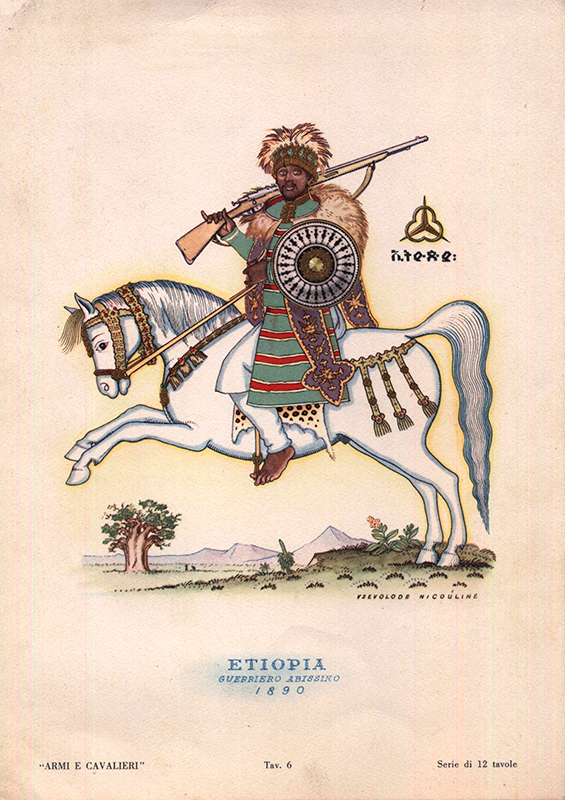
1890 Illustration – Mounted Ethiopian Warrior
The image appeared on an Italian pharmaceutical company’s advertising card printed in the 1930s. Although he still carries a shield, the soldier also shoulders a modern military rifle rather than the vintage flintlocks relied upon by the majority of his countrymen.
In 1906, the same year that Einstein set forth his Theory of Relatively that changed the face of science and the Great San Francisco earthquake changed the face that city, Ethiopia was granted its internationally recognized independence with Great Britain, France and Italy among those signing the historic document. But within five years Italy would invade nearby Libya and begin carving out chunks of northern Africa for its colonies. As the European powers began devouring African resources, Ethiopia still managed to survive intact, and furthermore, in 1923 was recognized by the League of Nations (the precursor to the United Nations) as a full-fledged member of that international community.

1937 – Coinage and Carnage
Along with the image of Emperor Selassie, his name appears in the abugida script form of Amharic, the country’s national language, and the second most-spoken Semitic language worldwide after Arabic.
* * *
While it went through a period of various potentates as rulers, a new leader appeared that would put Ethiopia firmly back on the world map. The face of Emperor Haile Selassie appeared on the November 3rd, 1930 cover of TIME Magazine. His titles included “King of Kings, Conquering Lion of Judah and Elect of God.” The text of the story stated, “Certainly the new Emperor is the greatest Abyssinian ruler of modern times.” That bit of hyperbole proved prophetic. TIME again placed him on its cover on January 6, 1936 selecting him as “Man of the Year for 1935” for his courageous efforts defending his country from the invasions launched by Italy’s fascist dictator Benito Mussolini.
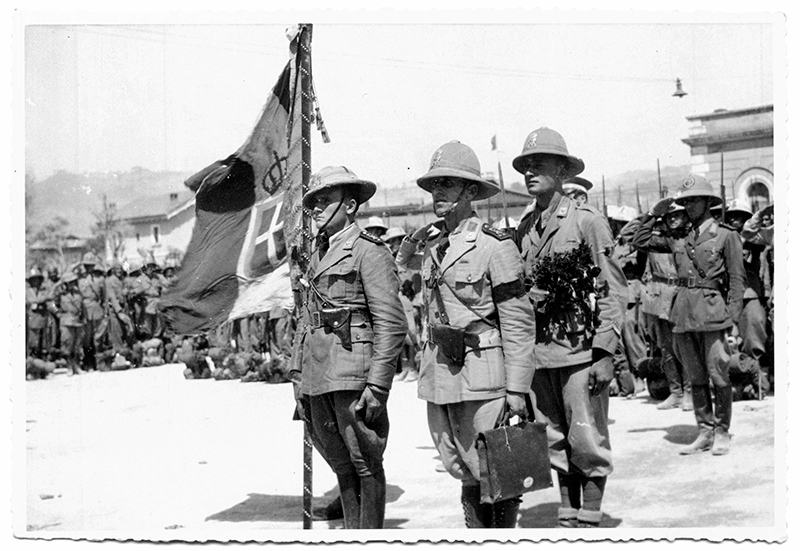
Banner of War
Standing by their battle flag, officers of the 225th Infantry Regiment of the 14th Italian Expeditionary Force prepare to depart for East Africa in 1935.
* * *
The Italo-Ethiopian War of 1935, lasting 17 months, would presage the European war that would erupt in 1939, and as such could be seen as one of the sparks that ignited that conflagration.
Since Mussolini dreamed of recreating the glory of the Roman Empire, he needed colonies to expand fascist Italy along with his own ego, thus Ethiopia became his target. The rest of Europe shrugged their shoulders for the most part. The attitude is summed up by the following quote from discussions at the Swiss Ministry of Foreign Affairs on October 3, 1935, the eve of Italy’s invasion of Ethiopia. “One can see now how thoughtless it was of the League of Nations to admit Ethiopia, a country which does not deserve other nations risking a war to protect it.”
As the war ground on, the modern Italian forces found themselves generally victorious, but on December 22, 1935, after Ethiopian troops managed to repulse an Italian attack, General Rodolfo Graziani launched airborne gas warfare including bombings on January 10 that killed thousands of Ethiopians trying to escape Italian advances, more gas attacks following in March. An estimated 300-500 tons of mustard gas were deployed, personally authorized by Mussolini along with the use of flamethrowers.
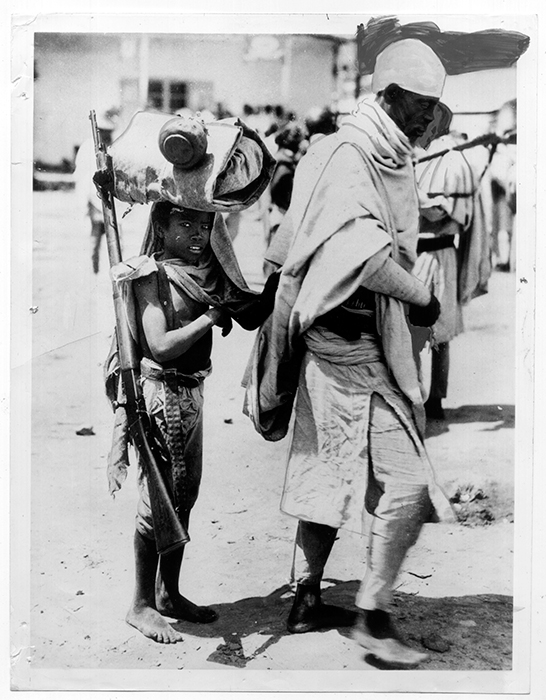
October 1935 – Mobilization in Harar, Ethiopia
Responding to Emperor Haile Selassie’s call for the defense of their country, an Ethiopian warrior and his young son prepar to leave for war, the boy acting as his father’s “squire” and carrying his rifle and gear. Like most of the soldiers facing the Italians, both go barefoot into battle.
* * *
On May 5, Italian General Badoglio and his troops triumphantly entered the capital of Addis Ababa. Eventually some 150,000 Italians would occupy Ethiopia, but the occupiers found themselves tasked with controlling over 1,000,000 sq. kilometers of some of the harshest topography in the world and home to some of the most tenacious and courageous peoples, many of whom joined in a protracted guerilla war.
Initially official international response was minimal. The only country to protest the Italian aggression and occupation was Mexico. A year later, five other countries…China, New Zealand, the Republic of Spain (fighting its own civil war against Fascism), the U.S. and U.S.S.R. were the only nations not to recognize Italy’ right of control over Ethiopia. However by 1940 only Stalin’s Russia recognized Selassie as the rightful leader, since at the time and prior to the isolationist leaning U.S. entry into WWII, America was considering acknowledging Ethiopia as part of the Italian empire.
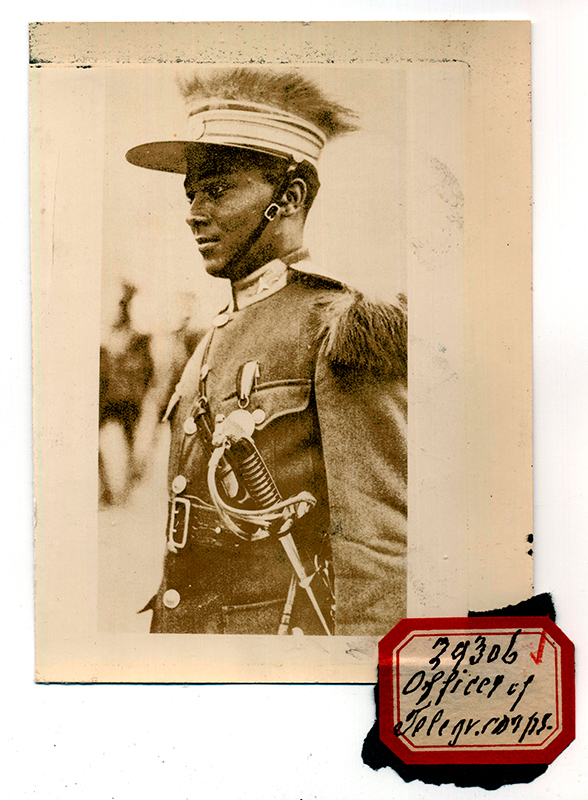
Ethiopian Royal Guard Soldier
Still bearing the original tag affixed to an album photo in 1935, an officer of the Telegraph Corp is shown in his dress uniform complete with lion fur fringed epaulets and cap. Unfortunately the country’s communication system was such that the military had in most part to rely on runners and there was but one field telephone in service.
* * *
On June 30, 1936, after Italian forces occupied Addis Ababa forcing him into exile, Ethiopia’s Emperor Haile Selassie made a personal and electrifying appeal to the League of Nations which had convened in Geneva, Switzerland. His speech, warning of the threat of Fascism, was heckled by the Italian representatives, but brought him into the world spotlight as a champion of his people and an inspirational call to defend the weak against the violently strong. His statements included the following prophetic warning:
“If a strong government finds it can destroy a weak people, then the hour has struck for that weak people to appeal to the League of Nations to give judgment in all freedom. God and history will remember your judgment. It is us today. It will be you tomorrow.”
His words went unheeded, the League taking no action. On February 19-21, 1937 Addis Ababa was the scene of a bloody massacre of some 10,000 civilians including half the younger, educated population, shot, beheaded, and bayonetted by Italian troops with the pretext being an attempted and failed assassination attempt against Marshal Rodolfo Graziani the Viceroy and Governor General of Italian East Africa. It was one of the largest mass murders prior to the start of WWII.

Souvenir Photo
An Italian soldier snapped this image of blindfolded Ethiopians as well as his pith helmet wearing comrades during one of countless public executions.
* * *
The Italians also operated notorious prisons, including Nokra located on an island on the Red Sea where prisoners suffered a mortality rate of 58%. The general Fascist attitude toward their colonial subjects was summed up by Gen. Badoglio when he stated, “the whole population of Cyrenaica should perish.”
In another instance, the Italian commander Graziani, employing Somali and Libyan mercenaries along with his Italian troops, successfully launched the decisive battle against the Ethiopian resistance on the Southern Front in mid-April 1936. His summary report of the victory indicated some 650 Italian casualties while the numbers exceeded several thousand Ethiopians. He commented, “Few prisoners as is the custom of Libyan troops.” While under Italian command who voiced no disapproval, the Libyans implemented their own “total war.”

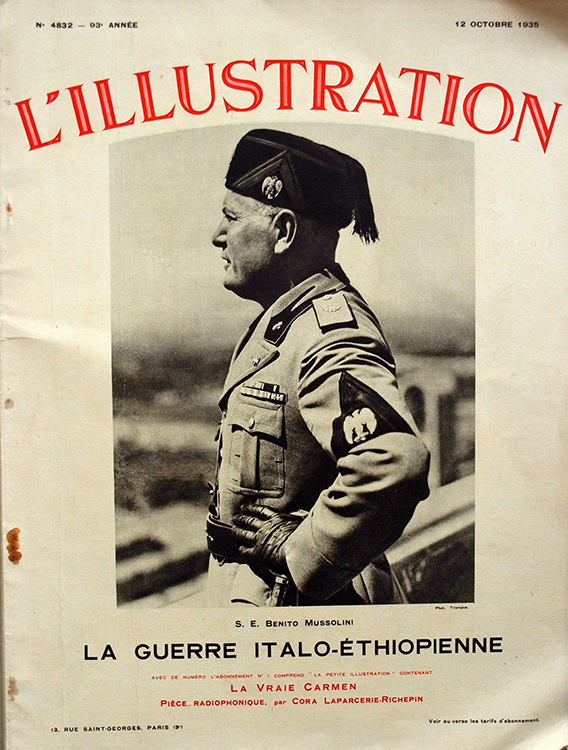
1937 Photo -Conquering Italian troops in High Spirits
Eventually an estimated 500,000 Ethiopians died as the result of Italy’s invasion and occupation, a genocidal policy that history relegated to its dusty back pages.
Italy would continue to control Ethiopia while the world lurched toward WWII. Then on June 10, 1940 Mussolini decided to enter the World War on Hitler’s side in order to share in the spoils. His forces attacked France via the western Alps, but suffered from poor leadership and freezing temperatures, obsolete weapons, without even adequate cooking pots or winter clothing. In the ensuing border area battles, the French sustained 40 killed, 84 wounded, 150 missing. The Italians lost 631 killed, 2,361 wounded and 600 missing not to mention some 2000 cases of frostbite. Later in Greece, Italian forces were driven back again, in this case losing some 14,000 dead and 25,000 missing. Hitler was called upon to rescue his Italian allies by sending in his own troops and as a result did not meet his original schedule for attacking the Soviet Union, losing precious time, and perhaps the war in Russia and the War itself.
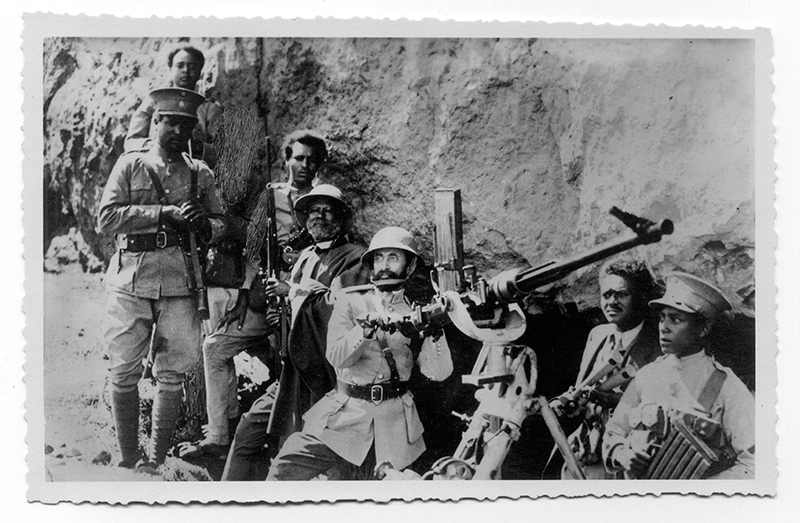
Attack on Dessie – Emperor Selassie Fights Back
The photo shows the Emperor at the controls of a Swedish made Oerlikon anti-aircraft gun. While the scene appears posed, it recreates an actual event. After learning that Selassie would be inside the vacated Italian consulate building, the Italians dropped bombs on the city, causing moderate damage and creating panic in the civilian population who had never experience aerial bombardment. The Emperor went unscathed while the bombing of civilians brought international attention.
* * *
In late January 1941, British and its Commonwealth troops (Indian, Nigerian, Ghanaian, South African, East African), launched attacks from bases in Sudan and Kenya against Italian-occupied Eritrea and Somaliland. By mid-February, 1941, Italian troops in Eritrea had sought sanctuary in the rugged mountains, for the most leaving their outposts in the hands of the Allies. By late March, German and Italian forces were evacuating by ship from Eritrea as British forces continued their successful operations against them. In one of the large engagements fought at the Battle of Keren involving tanks and infantry, the British recorded 536 killed, 3229 wounded while Italian casualties totalled some 6500.
On April 1, the Eritrean capital city of Asmara surrendered as an open city, the Allies collecting 5,000 Italian prisoners, the remaining forces making an effort to escape back into Ethiopia. By April 4th, Italian troops had fled the capital of Addis Ababa under threat of imminent capture by British forces who shortly took the city without opposition. On May 5, Ethiopia’s Haile Selassie made an historic return to the capital, marking to the day that he had been forced to flee Italian forces five years previously.
By May 16, Amba Alagi, the last major Italian stronghold in Ethiopia, lacking drinking water and counting nearly 290,000 casualties, began surrender negotiations. On May 17, 1941, Duke Aosta, the Viceroy of Italian East Africa, surrendered to the British followed on November 27 by the surrender of General Nasi, thus effectively ending Italian control of the area although some Italian guerrilla resistance continued until Italy surrendered in 1943, thus officially ending the Italian occupation of Ethiopia. It was Gen. Badoglio, the conqueror of the Ethiopians, who replaced Mussolini as Prime Minister after the dictator’s fall from power. Badoglio then surrendered Italy to the Allies.
Italian forces in East Africa would be captured en mass by Allied forces and during fighting on the Eastern Front alongside their German allies 87, 795 Italian personnel were killed or MIA, another 35,000 wounded. Over the ensuing decades, Italy was only able to repatriate the remains of 10,542 of its soldiers from the Russian Front, and of those only 2,799 were identified.
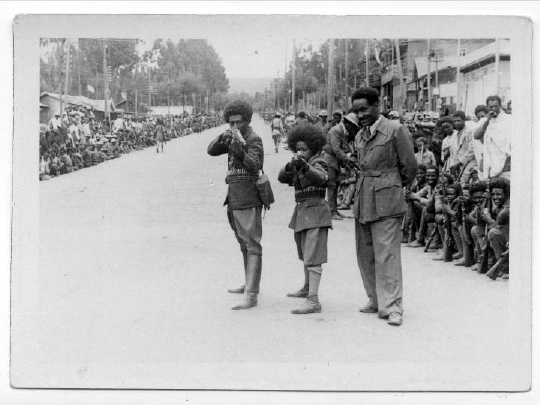
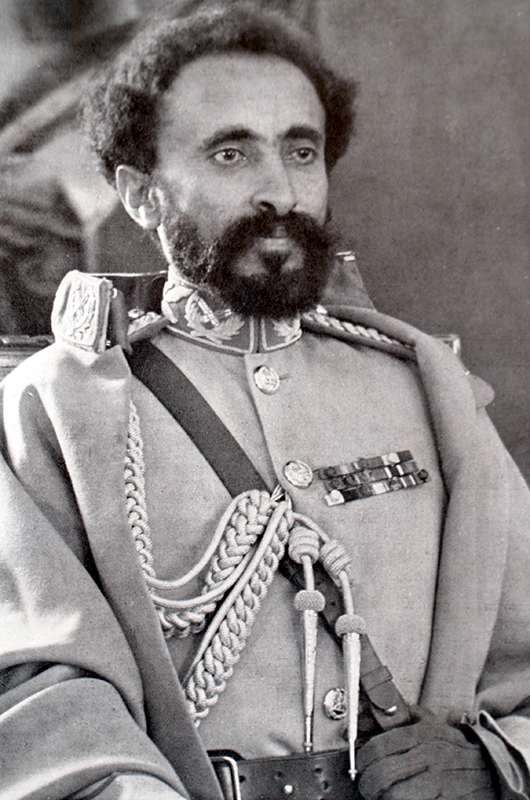
Victory Celebration
A rare private snapshot shows Emperor Haile Selassie standing on the main street of Addis Ababa on May 5, 1941, the day of his return to the liberated capital. The roadway is lined with smiling troops while two young riflemen aim for the cameraman. Today, May 5 is still celebrated as “Ethiopian Patriots’ Victory Day.”

Temporary Comrades-in-Arms
The body language of an Italian Alpini trooper and a German Army corporal standing at their guard post could be interpreted as reflecting the differences between their individual and national personalities.
* * *
After the overthrow of Mussolini and as a result of the Armistice of Cassibile on September 8, 1943, Italy was split between the pro-fascist forces allied with Nazi Germany and anti-Fascist forces with Allied allegiances. The Germans exacted brutal reprisals against the Italians they saw as traitors, executing thousands and sending thousands more into slave labor.
Italy paid the price in blood, nearly a quarter million of its military killed and another 150,000 civilians perishing, a significant percentage caused by its former German ally.
1948: Aftermath
War crimes charges against Fascist Italy, while assaulting pre-WWII Ethiopia and during the war in Greece and Yugoslavia, were never officially recognized or prosecuted as the both the post-war Italian government and the Allies preferred to ignore them—in fact, actively denying and covering them up since they were now more concerned with the threat of the Communist Party in Italy. However, Marshal Rodolfo Graziani, late Italian ruler of Ethiopia, was sentenced in 1948 to 19 years in prison for his collaboration with the Nazi Party. Although he only served four months. (He later became active in a neo-fascist party, dying of natural causes in 1955 at age 72. Public money funded a monument to him in 2012.)
BIO
 Paul Garson lives and writes in Los Angeles, his articles regularly appearing in a variety of national and international periodicals. A graduate of the Johns Hopkins Writing Seminars and USC Media Program, he has taught university composition and writing courses and served as staff Editor at several motorsport consumer magazines as well as penned two produced screenplays. Many of his features include his own photography, while his current book publications relate to his “photo-archeological” efforts relating to the history of WWII in Europe, through rare original photos collected from more than 20 countries. Links to the books can be found on Amazon.com. More info at www.paulgarsonproductions.com or via paulgarson@aol.com
Paul Garson lives and writes in Los Angeles, his articles regularly appearing in a variety of national and international periodicals. A graduate of the Johns Hopkins Writing Seminars and USC Media Program, he has taught university composition and writing courses and served as staff Editor at several motorsport consumer magazines as well as penned two produced screenplays. Many of his features include his own photography, while his current book publications relate to his “photo-archeological” efforts relating to the history of WWII in Europe, through rare original photos collected from more than 20 countries. Links to the books can be found on Amazon.com. More info at www.paulgarsonproductions.com or via paulgarson@aol.com














